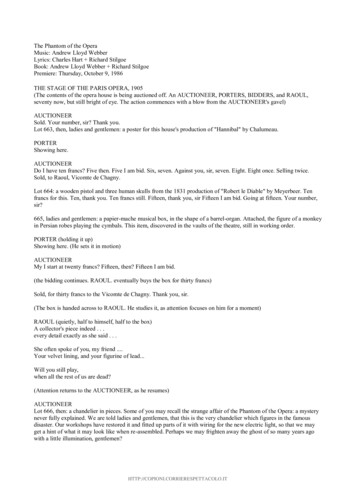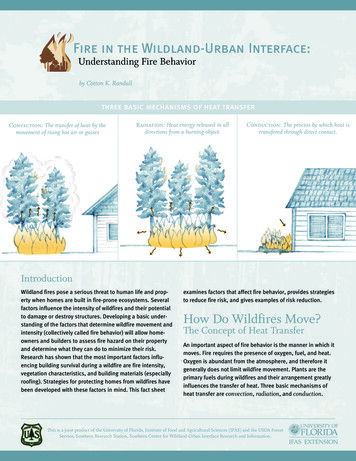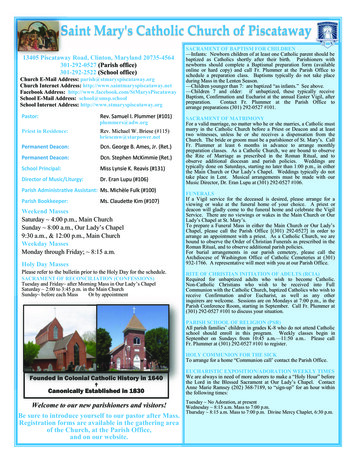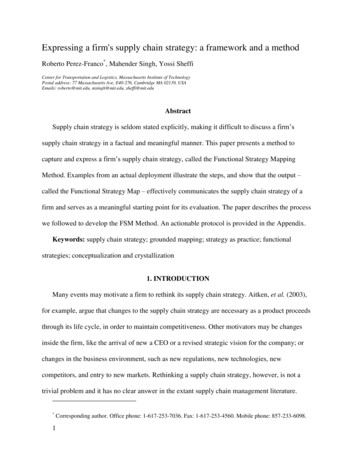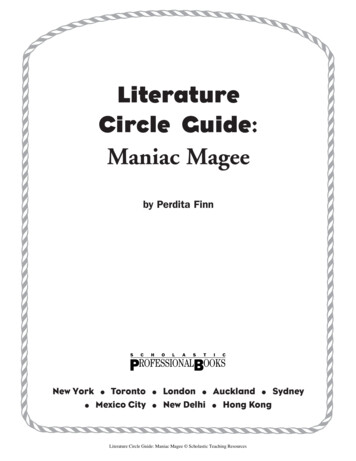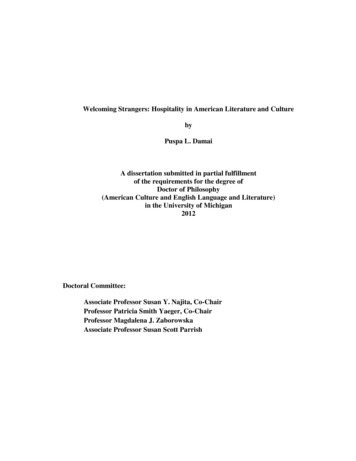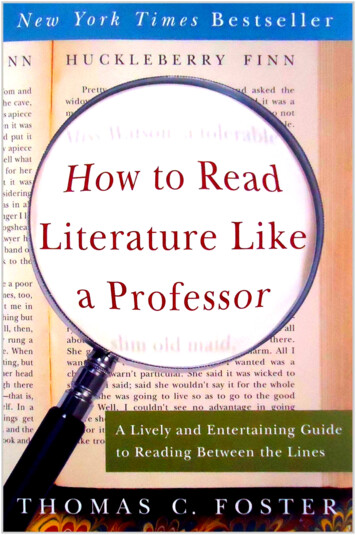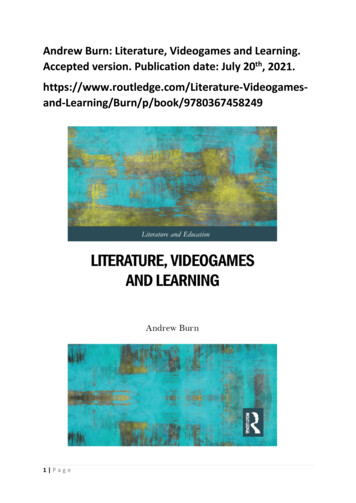
Transcription
Andrew Burn: Literature, Videogames and Learning.Accepted version. Publication date: July 20th, esand-Learning/Burn/p/book/97803674582491 Page
REVIEWS"Andrew Burn’s rich and nuanced new book offers a meditationon the relationship between games and literature, consideringwhat gets learned when students interpret classic works such asBeowulf and Macbeth through computer games. Along the way,he maps an ambitious and eclectic conceptual framework frommultimodal analysis. This book makes valuable contributions toour understanding of the nature of literacies (old and new)."Henry Jenkins, Provost Professor of Communication, Journalism,Cinematic Arts and Education at the University of SouthernCalifornia.“Scholars, creators, critics, and consumers of media divide theirattention into categories that feel natural—film, book, game. Butthe walls between them are also arbitrary. In this book, AndrewBurn demolishes and rebuilds them, showing how all media aremade of play, and play can become a new lens for teaching,understanding, and enjoying them.”Ian Bogost, Ivan Allen College Distinguished Chair in MediaStudies and Professor of Interactive Computing at the GeorgiaInstitute of Technology.“The most innovative proposal for reforming Englishclassrooms yet proposed. We have tended to think of literatureas content and games as activities. Andrew Burn shows us howto make literature come alive not just as words but as playfuldeeds and design. In the act, he is creating a whole new field.”James Paul Gee, Mary Lou Fulton Presidential Professor ofLiteracy Studies; Regents’ Professor, Arizona State University(retired)2 Page
“This book brings into focus profound and important insightsinto powerful links between the seemingly antithetical worlds ofLiterature and videogames. Grounded in deep knowledge ofboth, and of young people, pedagogy and curriculum, this bookbrings together decades of research with schools and majorcultural institutions. It shows in practice how games andliterature can work together, with students as active makers increative and productive ways. A major contribution fromAndrew Burn, the foremost figure in this field, it presents a richvision of the future of Subject English, and contemporary formsof communication, imagination and play.”Catherine Beavis, Professor Emerita of Education, DeakinUniversity, Australia3 Page
AcknowledgementsI owe a considerable debt of thanks to a wide variety of colleagues who have helped me think aboutthe relationship between literature and videogames, and have collaborated in the research projectsand teaching programmes which inform this book.Particular thanks are due to my close colleagues at UCL, Abel Drew and Bruno de Paula, for theiruntiring development work on the Unity-based Missionmaker software, and their inventiveness,deep knowledge of games, and cheerful commitment to a long string of projects. Bruno has alsohelped me to think about procedurality, coding and multimodality, which feature throughout thebook in various ways. I am also indebted to my colleague Diane Carr, whose profound knowledgeand insight in the field of digital games has made a success of the research projects we have sharedand the MA games module we devised together many years ago. My colleagues on the UCL Englishand Drama PGCE programmes also deserve my gratitude: Dr Theo Bryer, Dr Jane Coles, and alsoMorlette Lindsay (I’ll be sad not to be able to share the book with her). I have drawn extensively ontheir work in several chapters of this book. I’m also grateful to UCL colleagues and students on theMA Digital Media programme, especially Professor John Potter and Dr Brigitta Zics; and on ourdoctoral programme, especially Alison Croasdale, whose work with her students on games andimmersive narratives features in two chapters of the book.Beyond UCL, I am deeply appreciative of the creative and sustained support of colleagues who havecontributed to the research projects, and the development of Missionmaker: Donna and GaryBurton-Willcock, formerly of Immersive Education; and Andrew Kennedy of Moviestorm. I mustmake special mention of James Durran, my teaching, research and writing partner over more thanthirty years, whose extraordinary skills and pedagogic dexterity have made possible several of theprojects displayed in this book. Heartfelt thanks go to Stella Wisdom of the British Library, who hasbeen an unfailing supporter of Missionmaker, and made possible the launch of the two versions ofthe software: Missionmaker Beowulf at a Digital Conversations event, and Missionmaker Macbeth atthe Off the Page: Chapter 2 conference as part of the London Games Festival. I am grateful also toProfessor Andrew Prescott, who guided two of the projects in his role as lead Fellow of the AHRC’sDigital Transformations theme, and kindly spoke at our Beowulf conference at the British Library.I am grateful to colleagues, institutions and funding bodies in the research projects which the bookdraws on: to David Buckingham, Caroline Pelletier, Parkside Community College, and the Engineeringand Physical Sciences Research Council and Economic and Social Research Council (Making Games);Fiona Banks and Georghia Ellinas of Shakespeare’s Globe, Coleridge Community College and the Artsand Humanities Research Council (Playing Shakespeare); Professor Richard North, Dr Vicky Symons,Dr Simon Thompson, Dr Alison Gazzard, Professor Michael Anderson, Dr David Cameron, Abi Barber,Dr Calum Cockburn, Dr Rachel Burns, Dr Emily Klimova, The British Library, The National VideogamesArcade, students of Bishop Challoner School and Regent High School, and the Arts and HumanitiesResearch Council (Playing Beowulf); The British Library, Dr Nozomi Sakata, Professor Kimi Ishida,students of Bishop Challoner School, London and King James School, Knaresborough, and the UCLHigher Education Innovation Fund (Playing Macbeth).Finally, I am thankful to my editors in the Routledge Literature and Education series, Andrew Greenand David Aldridge, for encouraging me to embark on the book, and for their support and patiencein writing it. Closer to home, I owe an enormous amount to my wife Jenny, who has uncomplaininglylived in closer proximity to this book during the year of the pandemic than would otherwise havebeen the case, and been unfailingly supportive.4 Page
CONTENTSCHAPTER 1 - LUDO-LITERARY ENCOUNTERSCHAPTER 2 - LUDO-LITERARY AESTHETICSCHAPTER 3 - MULTIMODALITY IN LITERATURE AND GAMECHAPTER 4 - LUDIC LITERACIESCHAPTER 5 - GAMES AND CHILDREN’S LITERATURE I: THE NORTHERN LIGHTSCHAPTER 6 - GAMES AND CHILDREN’S LITERATURE 2: THE CASE OF HARRYPOTTERCHAPTER 7 - PLAYING BEOWULF 1: LUDIC RHAPSODIESCHAPTER 8 - PLAYING BEOWULF II: OF MONSTERS AND MANUSCRIPTSCHAPTER 9 - PLAYING MACBETH 1: CODING AND CREATIVITYCHAPTER 10 - PLAYING MACBETH II: FROM CHARACTER TO AVATARCHAPTER 11 - PLAYING MACBETH III: BLUE DRAGONS, MURDERERS AND THEENDLESS RUNCHAPTER 12 - EPILOGUE5 Page
LIST OF FIGURES1.1Prospero and Miranda in Prospero’s cell, from Year 9 Tempest level.2.1Jenna’s Harry Potter board game.2.2.1-4 Minqi Zhu’s Macbeth game.3.1Rescuing Ophelia from suicide in a Year 7 game of Hamlet.3.2Screenshot from game level design for The Tempest, made by three 13-year-old girls.4.1Poster designed by 12-year-olds for their game, Jimmie de Mora and the Dying World.5.1Deception mini-game in The Golden Compass.5.2The player executes a low belly slash as Iorek.7.1Missionmaker Beowulf: coding interface.7.2The giant puppet of the dragon created by participants in the Australian Beowulf workshop.7.3The giant puppet hand of Grendel in the Beowulf game-world, from the Australian Beowulfworkshop.7.4The final rule in the sequence which produces the Queen’s narrative function in the RegentHigh game.7.5The appearance of Beowulf in Arthur’s game.7.6.1-4 Battling enemies: Game designs in the Beowulf Club.7.7The gizmo positioning Aaron’s Dragon.8.1The manuscript world in Calum’s game level.8.2The Guardian of the Codices, from Calum’s game level.8.3The Monster Wall in Calum’s game level.8.4-5The two player options at the end of Calum’s game: Beowulf or Grendel.8.6The first pop-up from Rachel and Sasha’s game.8.7Screen from Will Crowther’s Adventure, 1975.8.8Rachel and Sasha’s code specifying player damage caused by the Bible.8.9Rachel and Sasha’s mirror effect, showing the player the image of themself as Grendel.9.1Year 9 Macbeth game: the player interface showing the economies.9.2The “Sewers of Lady Macbeth’s Mind” level.9.3The design interface of the girls’ level, showing the trigger volume.9.4The design interface in Missionmaker showing the design of Duncan’s murder.9.5-6The girls’ design of the witches.10.1Tom and Millie designing their Macbeth game.6 Page
10.2The students’ “pop-up”mission instruction to the player.10.3Inspection panel for Duncan’s skull in Tom and Millie’s game.10.4The rules for King Duncan’s skull in Tom and Millie’s game.10.5The students’ “spectral witches” design.11.1Designing the death of Duncan.11.2Sara annotates her copy of Macbeth in preparation for her game design.11.3Sara’s planning sheet for her game level.11.4Leanne designing her game.11.5The pop-up addressing the player as Lady Macduff.11.6The bloody corpse of Lady Macduff’s son.INTRODUCTION TO SAMPLE CHAPTERI've chosen Chapter 7 as a sample because it gives something of an overview ofprojects run by myself and colleagues in young people's game designs based, inthis case, on Beowulf. It draws heavily on my colleagues' published work, whilealso offering an in-depth analysis of one game made by a 10 year-old boy in theworkshop we ran at the National Videogame Arcade in Nottingham.The chapter refers back to some of the arguments I've made in previous chaptersabout the playful disposition of literature in general, the cellular nature of gamenarrative in particular, the multimodal qualities of videogames, and the kinds ofliteracies that game play and game design involve.It anticipates further chapters which go on to explore videogame transformations ofBeowulf by graduate students of Anglo-Saxon, and game designs of Macbeth bysecondary students in Cambridge, Yorkshire and London.I hope readers may find this sample a sufficiently interesting taster to lead them tothe whole book, which represents at least ten years of applied and theoreticalresearch, as well as a hinterland of experience in classrooms, which honed mysense of the literature game and what young people make of it.7 Page
CHAPTER 7 [sample chapter]PLAYING BEOWULF 1: LUDIC RHAPSODIESChildren’s rhetorical engagement with children’s literature and with game adaptations,presented in the previous chapter, revealed a critical understanding of the means used byliterature and games to persuade, entice, enchant, and be credible, authentic, convincing:the aspect of communication known in social semiotics as modality. A poetic engagementwould suggest an appreciation of what I’ve called, in Chapter 3, the semiotic toolkit of style:the distinctive configuration of patterns in communication by which its rhetorical aims areachieved, and by which it provokes affective response, whether these patterns (in the caseof literature) be lexical, grammatical, figurative, or prosodic. To extend beyond literatureinto other media, including videogames, these rhetorical and poetic configurations extendto a wide range of multimodal resources, including the code which constructs the rules ofthe game.In Chapters 5 and 6, we have seen how these patterns operate in games derived fromchildren’s literature; and explored the kinds of literacy involved in reading, playing, andengaging with fictional worlds across literature and game.This chapter will move on to games designed by young people themselves astransformations of the Anglo-Saxon poem Beowulf in a range of contexts, from schools tocoding workshops, drawing on the 2015 Playing Beowulf project described in Chapter 1.The case of BeowulfBeowulf is the best-known of a small surviving group of Old English poetry, existing in aunique manuscript held by the British Library, the Nowell codex. The circumstances of itscomposition and poetic nature are the subject of intense debate; indeed, almost everythingabout Beowulf is contested. Coles and Bryer (2018), who were partners in the project,suggest that its very instability and history of translations and transformations is preciselywhat makes it an ideal text for the project described in this and the next chapter, a projectwhich included transformation into theatre, film and videogame:Consequently, with its history of material and cultural adaptations andappropriations, its relation to popular fantasy genre and its heroic subject-matter,Beowulf presents us with an ideal literary text for exploring the transformativerelationship between literature, drama, filmmaking and digital games. (Coles andBryer, 2018: 55).One debate in the scholarly history worth dwelling on briefly concerns the question of oralcomposition, with some scholars, notably Albert Lord (1961), arguing that Beowulf fitted theoral-formulaic pattern, suggesting oral composition and development over time, and onlyeventual transcription. Others disagreed: Benson, for example, argues that “we shouldassume literate production of those poems, such as Beowulf, with qualities contrary to what114 P a g e
oral composition might lead us to expect, and I refer here not to its cyclic character but tothe sophistication of its diction and structure” (Benson, 1962: 340). However, somewhatconfusingly, he concedes that “this poetry is obviously formulaic even when lettered, andthe study of its formulas and themes need not be based on an assumption of oralcomposition. Because Old English poetry is formulaic, our study of it must begin with theexciting and useful techniques developed by students of oral verse” (Benson, 1962: 340).Meanwhile, Tolkien’s influential 1936 lecture ‘The Monsters and the Critics’ had alreadyeffectively shifted the ground of Beowulf scholarship from philological study of the text asan interesting piece of linguistic history to literary study of its qualities as a poem(1936/2006).I’ll return in the next chapter to the implications of these debates for literature students inHigher Education. What, however, are the implications for teachers in secondary, evenprimary education?One point worth salvaging from the debate over the oral tradition may be to note theagreement over Beowulf’s formulaic qualities, a feature quite distinct from the poetics ofmodern literature, where the very idea of ‘formula’ seems to fly in the face of notions ofcreativity, particularly those of the Romantic period. These modern preconceptions surfaceregularly in debates about creativity in education (c.f. Banaji et al, 2007), where originality(seemingly the opposite of formula) is often prized.Whether Beowulf conforms to the oral-formulaic or to Benson’s ‘written-formulaic’, toinclude it as such in the school curriculum is to admit a productive counter-example to theseideologies of creativity and literary value. Perhaps a useful way to look at it is to see Beowulfas occupying the middle ground between orality and literacy, the ground describedmemorably by Walter Ong in Orality and Literacy: the Technologizing of the Word. In manyways, Beowulf exhibits Ong’s ‘psychodynamics’ of oral narrative (Ong, 1982). In particular,the figure of Beowulf himself is what Ong called a ‘heavy hero’: characterised by simple,memorable qualities; and agonistic, solving problems through physical action rather thanpsychological effort. I note in passing that Caillois’s typology of games includes an agonisticcategory, representing games of combat (Caillois, 1958/2001). As I have argued in Chapter1, this literature is already playful.It is true that the poem is considerably more complex than many appreciate, and that thelengthy segments of apparent diversion into quasi-historical passages, tribal feuds andepisodic flashbacks are markedly different from the main episodes which modern mediatransformations almost exclusively focus on. Tom Shippey refers to these as the A and Bparts of the poem (Shippey, 2016). The A parts are complex, involved, heavy with names ofcharacters who play little or no part in the poem’s narrative, creating ‘the Beowulfianimpression of depth’ (Shippey, 2012: 260). The B parts are simple, consisting of the threebattles with Grendel, Grendel’s Mother, and the Dragon, with no names other thanBeowulf, Grendel, Hrothgar, and Beowulf’s friend and successor Wiglaf (Shippey, 2016).However, history has, in effect, made its choice: these dramatic battles with the monstersare the feature of the poem which Tolkien promoted, and adapted in his own fantasy115 P a g e
writing; they are the parts which excite the imagination of modern audiences. As such, theyare the parts which schools will focus on; and which even the university students of AngloSaxon literature choose, as the next chapter will show.The B sections particularly illustrate that Beowulf is in many ways what we now think of as apopular cultural text. This strong, formulaic narrative in which a mighty hero battles fantasymonsters may be the earliest jewel in the crown of English literature, performed in themead-halls of kings as well as for the common folk; but it resembles the adventures ofSpiderman, Superman and Batman more than it resembles the tortured protagonists ofRenaissance drama or the modern novel. This is not to dismiss the psychological insights,descriptive power, social critique and aesthetic innovation that the prose and poetry of themodern era produce; nor indeed the literary merit of Beowulf. It is not necessary to preferthe archaic and fantastic over the modern and naturalistic, or the reverse, when both areavailable.The association with popular culture grows stronger with the media transformations ofBeowulf. After a number of other film versions, it was produced as an animated film in 2007(Zemeckis, 2007). In comic-book style, scripted by the graphic novelist Neil Gaiman, itrepresented Beowulf as a muscled super-hero (voiced with Cockney bravado by RayWinstone), and Grendel’s mother as a naked temptress (Angelina Jolie); though it alsoincluded excerpts from the poem in the original Old English and detailed attention to othercharacters in the narrative, such as Hrothgar’s queen, Wealhtheow, and the envious thane,Unferth.The Beowulf movie is valuable for the English and Media teacher as an example of thecontinuity of popular narrative, of how its tropes, structures, values and affective chargedescend in a discernible line from the archaic worlds of Achilles and Beowulf to thesuperheroes of Marvel comics. It is the line of descent that can be traced through thetransformative threads which take Arthur and the Matter of Britain from early mediaevalverse, both English and French, through Malory’s great prose epic, to Tennyson’s mournfulidylls, T.H. White’s comic genius, and the profusion of film and television of the twentiethand early twenty-first centuries, the most recent being the 2020 Netflix series Cursed, basedon the story of Merlin’s nemesis Nimue, and co-curated by the celebrated comics authorFrank Miller.Let’s move on, however, and look at the relatively new medium of computer games. Theanimated film of Beowulf was further adapted into a computer game version (Ubisoft,2007), in which the player takes the role of Beowulf, facing a series of challenges mostlybased on the narrative in the poem, and including, of course, Beowulf’s three great battlesagainst Grendel, Grendel’s Mother, and the Dragon. In each case, the combat sequence ismanaged through programmed game mechanics in which the vulnerability of bothprotagonist and antagonist is registered on-screen as a health bar.An argument for English teachers to consider is that computer games are particularly wellsuited to adapt the ancient narratives of oral (or quasi-oral) tradition I have describedabove. This is partly because they share the popular cultural milieu of their sister media116 P a g e
forms. But it is also because they are, literally, formulaic texts, made up of computer code.Suppose you want to describe the death of a warrior in battle. The sensibility of modernliterature requires variety and originality – cliché and formula are the enemies. We needdifferent words to describe the warrior’s fall each time; different words to describe thesounds of battle; novel ways to render the agony of death. For Homeric texts, the oppositewas true. The oral poet, performer and audience needed the repetition of the same wordsfor these familiar scenarios: words that could be easily remembered, easily re-ordered if theperformer needed to alter the narrative, and easily recognised by an audience whichrequired variations on a familiar theme. The battlefield slaughter of The Iliad follows a wellrehearsed formula of weapon use, disembowelling and the ringing of armour about thefallen warrior. The computer game is not dissimilar. The character is a bundle of audiovisualresources, constant through the game. The actions of killing an enemy will involve triggeringthe same animation cycle, the same soundtrack, the same range of player options eachtime. As in the oral performance, significant variations on the theme are possible, such asthe way in which these options can be exercised by the player. Although computer gamesare very different from traditional oral narratives in many ways, both employ formulaicnarrative techniques, integral components of the popular aesthetic.An ‘oral-ludic sensibility’, then, might have much to offer the cultural work of the Englishand Media classroom, offering a recuperation of ancient stories, styles and values; adramatic engagement for students with the protagonists of these narratives; a goal-orientedapproach to the problems of everyday life; and a reminder of the importance of pleasureand play. In this respect, I have used the compound figure of the rhetor-rhapsode in Chapter4 as an image of how young people may engage with literature, but also construct their owncreative expressive work, in writing certainly, but also in drama, in image, in moving image,and in game design. Though the rhapsode is the classical Greek figure who ‘stitches poetry’,the Anglo-Saxon scop performs the same task. The case studies presented in this chapterwill explore how young people might (re)stitch digital poetry through game design.The Beowulf projectThe aim of this project was to develop a bespoke game-authoring tool for Beowulf, based onMissionmaker, and to research its use with a range of groups using it for different purposes.The questions posed by the project were: what kind of engagement with the poem are inevidence in the game design process? What kinds of transformation of the poem areevident in the game? What kinds of creativity are involved?The project was a collaboration with The British Library, which holds the only manuscript ofBeowulf, part of the Nowell Codex, one of two manuscripts within the collection designatedas Cotton Vitellius A, xv. Digital Curator Stella Wisdom worked with the project team todevelop the game-authoring software, and to find ways to integrate into it digital pagesfrom the manuscript, which was one of the major early digitisation projects of the Library. Itled to a further project we also made use of, the Electronic Beowulf project at the Universityof Kentucky, which makes publicly available high-resolution images of the manuscript117 P a g e
leaves, alongside a digital version of the text in Old English, with a range of interactiveresources enabling, for example, translation of individual words (Prescott, 1997).This chapter will consider a series of examples of games designed during the project. Thesestrands were led by my colleagues in the project team, and I draw substantially on theirwork in providing these accounts. I’ll first briefly describe the software tool.MissionmakerThe origins of this software lie in the first Missionmaker, developed in 2007 by ImmersiveEducation, as described in Chapter 1. For the Beowulf project, the tool was completely redesigned in the game engine Unity (www.unity.com) by developers Abel Drew and Bruno dePaula. In this version, the tool provides a design interface (Figure 7.1) allowing for rapiddesign of the game world by placing 2D tiles representing chambers. In MissionmakerBeowulf, these include medieval-themed locations, including the mead-hall, Heorot, themere where Grendel and Grendel’s Mother live, and the cave in the cliff-face where theDragon’s lair is found. A subsequent interface displays this world in 3D, allowing users toplace assets (characters, props, pickups, media objects) directly into the world. Theseinclude generic mediaeval characters, armed warriors, a King and Queen, two monstrouscharacters, and a Dragon. A further interface allows the creation of rules, with the possibilityof multiple conditions with Boolean operators (e.g. “If Rune-spear clicked/ OR Rune-spear state owned by player”) and multiple actions consequent on those conditions (e.g. “DoorState Open True / AND Warrior character State Aggressive True”).FIGURE 7.1: Missionmaker Beowulf: coding interface.118 P a g e
De Paula explains how this coding interface provides a simple, ‘high-level’ programminglanguage:One important aspect regarding ‘‘coding’’ in Missionmaker is the programminglanguage: producers use a constrained form (context-sensitive lists) of naturallanguage to design their games. This approach [provides] an easier means to grasphow to organise and communicate commands to the computer than regularprogramming language; moreover, the constriction of natural language avoids syntaxerrors (e.g. typos or use of words not recognised by compilers). Due to this easierapproach to game design, MissionMaker can be considered a ‘‘low floor’’ [Burke andKafai, 2014] tool, meaning that beginners can start producing their own gameswithout having to resort to complex knowledge.(De Paula et al., 2017: 43)The projects described in this chapter, and in Chapters 8-11, all use a version of thissoftware. It enables us to look closely at the multimodal toolkit of visual, auditory andprocedural resources are used by the young people in their game designs, and how theseuses transform the literary texts around which the projects are based: Beowulf andMacbeth.Australian Theatre for Young People in Sydney, Australia.This project was organised by project partners Professor Michael Anderson of the Universityof Sydney, and Dr David Cameron of the University of Newcastle, Australia, building on theirwork over many years on the relationship between educational drama and game design.Accordingly, the workshop participants devised a piece of theatre based on the poem, usinggiant puppets which they constructed with a local puppeteer, Phil Relf. At the same time,they designed their own games using Missionmaker, and then incorporated selections fromthe games into the drama through large-scale projection. The work explored how narrative,combat, heroic quest and monster figures can be realised in the cognate forms of dramaand game.The game used in the performance was captured as a video sequence, onto which a greenscreen superimposition of the giant puppet hand of Grendel represented the player’s pointof-view as Grendel, moving through the virtual mead-hall of the videogame (Figure 7.2). Thisis one example of the ingenious mash-ups of drama and game achieved during the week.The lessons derived from the project about how game-worlds and drama-worlds can beintegrated, along with the cultural traditions, technologies and pedagogies associated withthem, is elaborated by Anderson and Cameron in a chapter for an edited book themedaround play in different social contexts (Anderson & Cameron, 2017).Here, then, the processes of transformation of the poem are subject to the poetics of dramaand media arts, and exploit the overlap between the two. They both involve the creation ofimagined worlds and the characters which inhabit them, with point-of-view differentlyconstructed in the drama and the game. They both involve role-play, as Carroll anticipated119 P a g e
in his early essay on this subject (2002); though again, differently experienced, embodied,voiced, in game and drama. They both exhibit forms of ‘literacy’ which emphasiseimprovisatory, agile forms of making, which are performative in the very act of designingperformance – which are, in short, dynamic in the sense described by Potter and McDougall(2017). Finally, the stylistic toolkit drawn on here is, as I’ve described it in Chapter 3,multimodal, merging the rather different multimodal ensembles of digital game (animatedobjects and characters, 3D graphics, first person avatar); and devised theatre (papier-machépuppets, bodies, dramatic action, voice, music, dramatised space).FIGURE 7.2: The giant puppet hand of Grendel in the Beowulf game-world, from theAustralian Beowulf workshop.British Library Young ResearchersAt Regent High School, a group of Year 9 students worked with the British Library’s YoungResearchers programme, which works with young people at risk of exclusion in London. Inthis case, programme coordinator Abi Barber from the British Library organised eight afterschool workshops, working with Head of ICT Rob Conway and English teacher Diana deBortoli, and with UCL IOE researchers: myself and Bruno de Paula.The group began by looking at extracts from Beowulf in translation, and by visiting theBritish Library to see the manuscript. They went on to design their own videogame versionsof the poem, using Missionmaker.A challenge for all the school workshops was to forestall perceptions of the story as maledominated sequences of combat, especially for boys. While this may seem a stereotypicalconsequence of gendered gaming cultures, it is more complex. Interpretati
10.3 Inspection panel for Duncan’s skull in Tom and Millie’s game. 10.4 The rules for King Duncan’s skull in Tom and Mil


